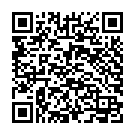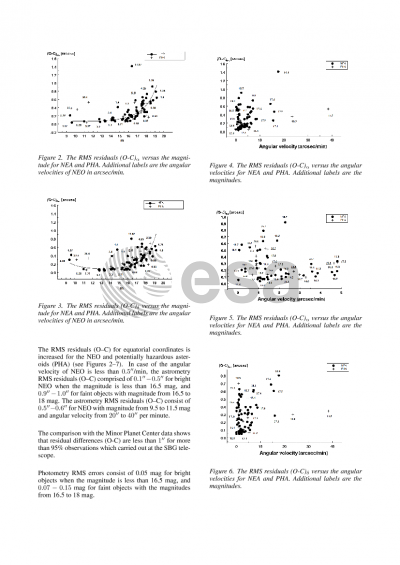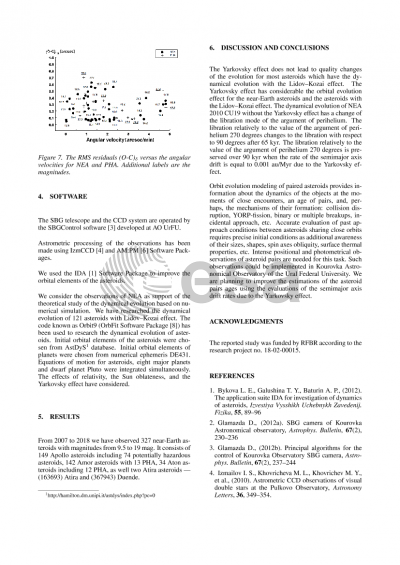Document details

Abstract
With the SBG telescope of the Kourovka Astronomical Observatory of the Ural Federal University, it carried out astrometric and photometric observations of the near-Earth objects. The four-axis telescope with a 0.8 m focal length is equipped with a Schmidt optical system and a 0.4 m diameter primary mirror. An Alta U32 CCD camera with a KAF-3200ME-1 CCD matrix containing 2184 x 1472 elements, each of size 6.8 x 6.8 μm is mounted at the main telescope focus. The scale of the CCD image is 1.8 arcsec/pixel. The field of view of the system is 65 x 44 arcmin. The precision timing system uses a 12-channel GPS receiver Acutime 2000 GPS Smart Antenna. Astrometry RMS errors consist of 0.01-0.3 arcsec for bright objects (magnitude is less than 18.5) and 0.5-0.7 arcsec for faint objects (magnitude is 18.5-19). Astrometry RMS errors comprised of 0.1-0.5 arcsec for bright objects (magnitude is less than 16.5), and 0.9-1.0 arcsec for faint objects (magnitude is 16.5-18) in case of NEO with angular velocity is less than 0.5"/min. Astrometry RMS errors consist of 0.5-0.6 arcsec for NEO with magnitude from 9.5 to 11.5 and angular velocity from 20" to 40" per min. Photometry RMS errors consist of 0.05 mag for bright objects (magnitude is less than 16.5) and 0.07-0.15 mag for faint objects (magnitude is 16.5-18). Comparison with the Minor Planet Center data shows that residual differences (O–C) are less than 1 arcsec for more than 95% observations which carried out at the SBG telescope. From 2007 to 2018 we have observed 327 near-Earth asteroids (magnitude is 9.5-19). It consists of 149 Apollo asteroids including 74 potentially hazardous asteroids (PHA), 142 Amor asteroids with 13 PHA, 34 Aton asteroids including 12 PHA, as well two Atira asteroids – (163693) Atira and (367943) Duende. We plan to present the first results of photometric observations of (155140) 2005 UD that is an additional target of the DESTINY+ mission.
Preview





